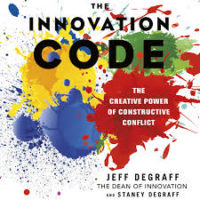Jeff and Staney DeGraff
The Innovation Code
I have an intriguing title that I love. Senior Fellow for Innovation at the Alliance for Peacebuilding. There’s just one problem. I’m not sure what my title means other than looking for ideas that could spark new initiatives by our members and others.
So, when I see a book with a title like The Innovation Code, I immediately read it. This was well worth it for at least four reasons above and beyond the fact that it is a short book you can read in an afternoon, though you will undoubtedly spend a lot more time thinking about it.
First is a statement they make toward the end of the book. “Collaboration has recently emerged as the defining characteristic of creativity and growth in nearly all sectors and industries.” I think they’re right except for the sectors and industries I work in that all include social and political policy making. Long before Donald Trump was elected, you would have been considered out of your mind if you said this about political life in any country I know about. So, maybe we should take them seriously and work to innovate and collaborate more there, too, which is what my next book will be about.
Second, they start the book by suggesting that we encourage conflict if we want to be innovative. Thus, the first paragraph of the preface includes this line. “It’s best that we innovate not with people we agree with but with people who challenge us.” Rather than surround ourselves with people like ourselves, they suggest working with your polar opposite if you want to do something other than business as usual. My friends and colleagues in the peacebuilding world talk a lot about teamwork, but few of us go this far and actively seek out people we disagree with and make them part of our teams. They then develop four archetypes which they label the artist, engineer, sage, and athlete, and make the case that a truly innovative team needs them all. And that we all need to find ways of incorporating some of each type’s characteristics in our own ways of working.
Third, they don’t encourage conflict for conflict’s sake. Rather, they stress the importance of bringing together diverse teams that share at least some kind of “shared investment in the project.” They understand that there will be painful moments when different points of view and different leadership styles intersect, but help the reader also see that digging deeper into the root causes of a problem helps uncover that common ground that none of you might have seen before the conflict began in what they call hybrid solutions.
Finally, they help us figure out ways of working with people whose modus vivendi is different from our own which always involves heightening our understanding of or empathy with people whose styles are different from our own. Of their four categories, I come closest to being an artist in the sense that I like to take risks, incite change, dream big, and so on. I’m not great when it comes to details. I don’t follow rules easily. I’m impatient. I know from first hand experience that it helps to understand the worldviews of my colleagues who are more detail driven, competitive, or process focused than I am. Indeed, I plan to spend more time trying to understand and even emulate the skill sets of what they call the athlete and the engineer whose styles are very different from my own and as important to building peace as any dreamy idea I will ever dream up.
So, check out this book and their consulting group, the Innovatorium which is located in Ann Arbor just a block or two from Haven Hall and the Institute for Social Research where I did my PhD. Those were exciting and innovative times for those of us in the social sciences. Alas, I walked by the Ross School of Business (where Jeff DeGraff teaches) almost every day and never thought of it as a place to learn about innovation.
which is located in Ann Arbor just a block or two from Haven Hall and the Institute for Social Research where I did my PhD. Those were exciting and innovative times for those of us in the social sciences. Alas, I walked by the Ross School of Business (where Jeff DeGraff teaches) almost every day and never thought of it as a place to learn about innovation.
My bad..

